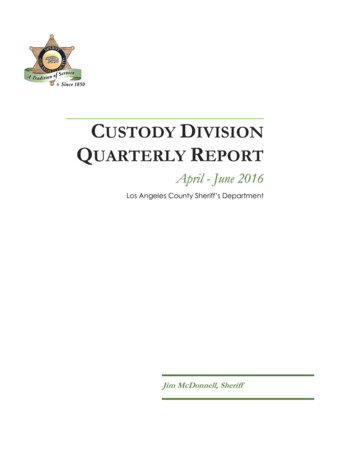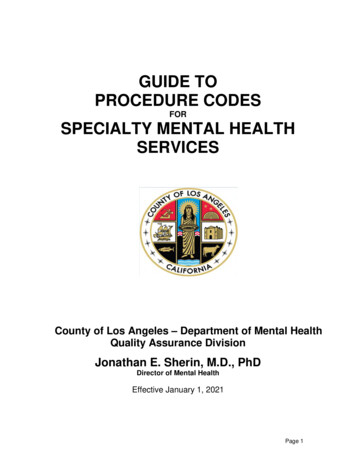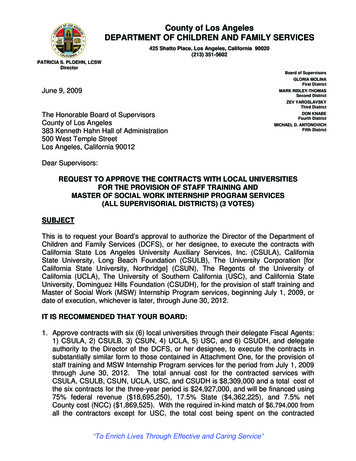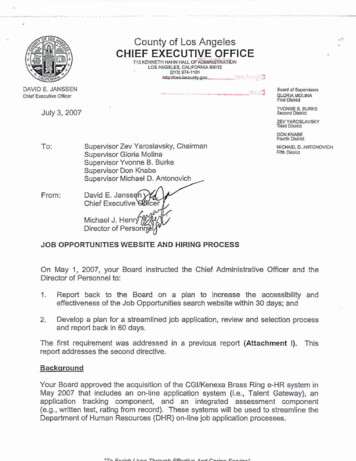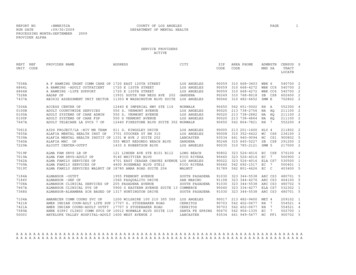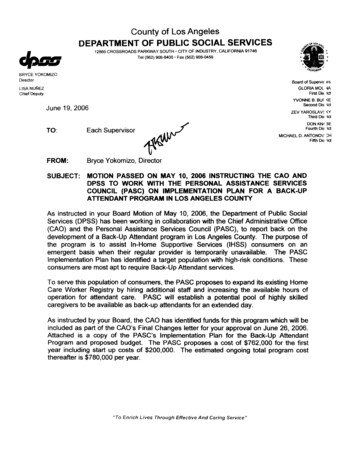
Transcription
The Los Angeles Count y17th Semiannual Reportby Special Counsel Merrick J. Bobb and Staffand Police Assessment Resource Center (PARC)November 2003
S p e c i a lC o u n s e lSpecial CounselStaffSenior AdvisorsMerrick J. BobbPolice AssessmentResource Center(PARC)Allyson CollinsCaptain Ronald Davis,Oakland PoliceDepartmentJulie FalkOren RootDjango SibleyChristy WegenerConnie YueNorma ZamudioChief Thomas Frazier,Baltimore PoliceDepartment (retired)Chief William Finney,St. Paul PoliceDepartmentConsulting PsychologistZoltan Gross, PhDConsultantJulio A. Thompsona n dS t a f f
C o n t e n t s1.2.Introduction1Use of Force and Inmate Violencein Custody Facilities5Trends in Use of Force and Inmate Violence6Force Management Strategies11Force Training24LASD POLICY RE CONTACT WITHINSUBORDINATE INMATES35The Facilities Automated Tracking37System (FAST)3.Historical Background39System Design and Capability43Areas of Concern and Suggestions for Improvement55LASD INMATE COMPLAINT DISPOSITION DATA FORM )68The Inmate Reception Center61Overview of IRC’s Operations72Overdetentions and Erroneous Releases73Use of Force83APPENDIX93
S e v e n t e e n t hS e m i a n n u a lR e p o r tIntroductionThis is the Seventeenth Semiannual Report of Special Counsel commentingon the Los Angeles County Sheriff’s Department (LASD) for the Board ofSupervisors, the Sheriff, and the general public. Special Counsel’s reportsdescribe the LASD’s efforts to implement a wide variety of reforms and identify additional areas for improvement.In this report, which reflects the status of the Department in the summerand fall of 2003, we focus on several aspects of the LASD’s operation of theLos Angeles County jail system. That system, with an inmate populationranging from 17,500 to 22,000 over the past decade, is the largest in thecountry. In this report, we touch upon three particular areas of the LASD’scustody operations.Chapter One examines inmate violence and the use of force by LASDpersonnel. The Department undertook several violence management initiativesin the wake of inmate rioting in 2000. The following year violent disturbancesdeclined substantially. However, some of these initiatives — which included aproblem-solving “Liaison Deputy” program, and the segregation of younger,more violence-prone inmates — were subsequently discontinued because ofbudgetary constraints. And although several promising and commendablestrategies are still in operation, a significant increase in violent disturbancesbegan in 2002 and continues to the present. Moreover, inmate assaults on bothinmates and staff also increased over the same period.1
Our examination of recent trends in the use of force by LASD personnelfound that significant reductions in the number of force events achieved in2001 have since reversed, with uses of force rising steadily since 2002. Ourreview found that the LASD has been pursuing some positive force management strategies including promoting the use of OC spray in lieu of riskierforce options; requiring a supervisory presence in certain high-risk scenarios;and conducting generally (although not universally) effective investigationsand reviews of incidents where force is used.An important component of the LASD’s force management program isthe training it provides to its employees in the use of force. However, gaps inthe current training system allow lateral transferees and newly-promotedsupervisors to work in custody facilities for substantial periods of timebefore they receive necessary force training — potentially leaving these staffmembers unprepared to defend against assaults or to appropriately controlviolent inmates. Moreover, no mechanism currently exists to ensure that allcustody personnel receive in-service force training, while recent changes to thein-service program have led to deep cuts in the amount of training providedin this critical skill area. In addition, some custody facilities are providing“in-house” force training that is insufficiently regulated by the LASD.Chapter Two addresses one of the LASD’s principal tools in managingrisk, the Facilities Automated Tracking System (FAST). FAST is a sophisticated relational database that tracks a broad range of custody-specific, riskrelated data, from officers’ use of force to inmate suicide attempts. Thedatabase enables Department managers and executives to conduct complexanalyses of risk-related trends, from increases in particular types of inmateinjuries, to identifying officers who may account for a disproportionate useof force.While FAST is excellent, we found areas for improvement. FASTreports numerous details regarding inmate complaints, but does not provide2
a way to identify Department employees accused of misconduct. A relatedconcern is that FAST does not break down personnel complaints by category,such as excessive force, discourtesy, or discrimination. Accordingly, managerscannot examine trends about the officers who generate complaints or aboutthe types of complaints lodged against their employees. In response to ourproposals, the Custody Division agreed to modify FAST to capture thisinformation. We also had concerns about the software application used forFAST, and the fact that there is only one person fully familiar with theprogram.Another area of concern was quality control. After discussions with ourstaff, the Custody Support Services unit has agreed to increase the number ofquality control mechanisms and therefore reduce the risk of tardy or inaccurate data entry.Chapter Three focuses on the Department’s Inmate Reception Center(IRC), which serves as the hub through which new prisoners enter the jailsystem, are sent to and from court appearances, and leave the jails whenreleased or transferred to other facilities. We reviewed three aspects of IRC’soperations: overdetention of inmates; erroneous releases; and use of force.Overdetentions continue a sharp downward trend, with only 49overdetentions for the first nine months of this year compared to 607 for allof 1997 and 249 for all of 2000. Much of the continued downturn appearsto stem from the In-Court Release and Greenband Program, which reducesthe risk of mistaken overdetentions by releasing inmates at the courthouse.Erroneous releases have also recently declined, although the trend overthe last several years has been inconsistent. We reviewed the erroneousrelease cases from the past several years and did not perceive any systemic orpersonnel problems that led to the mistaken releases. Beginning this yearIRC has added a second layer of review designed to identify potential overdetentions and erroneous releases.3
IRC has shown improvement in the area of force. Over the past fouryears, IRC has faced a steady increase in its average daily inmate populationwhile its staffing has increased only slightly, resulting in an inmate-to-officerratio today that is nearly double what it was in 1999. Nonetheless, when wecontrol for the change in inmate population by looking at force incidents per1000 inmates, there were only 1.47 such incidents for January – midSeptember of this year, compared to 1.95 incidents per 1000 inmates lastyear, 1.54 for 2001, and 3.85 for 2000. In addition, we were encouraged tosee this year two initiatives designed to better manage use of force: monthlyforce review meetings and supplemental, skills-based training regardingencounters with mentally ill inmates.We audited roughly 40 percent of IRC’s use of force incidents fromJanuary 2002 through September 2003 and found that, by and large, forcecases were investigated and presented for decision in a thorough, balancedmanner. In addition, we found that many of the cases appropriately identified issues of tactics and training that might assist officers to avoid futureinjury or even to avoid future confrontation altogether. Nonetheless, wefound a small incidence of problems requiring closer attention.Following Chapter Three is an Appendix with tables setting forth datawe routinely collect and publish concerning LASD-related litigation and useof force.4
Use of Force and Inmate Violencein Custody FacilitiesIntroductionThe task of managing the use of force by officials and the violencecommitted by inmates in the Los Angeles County Sheriff’s Department’sCustody Operations Division (hereafter referred to as “Custody Division” or“Custody”) facilities 1 presents significant challenges at the best of times.These times, however, are far from the best: budgetary constraints haveprompted reductions in the population capacity of the jails, with a consequent concentration of more serious offenders in the inmate population.Those same constraints have simultaneously caused cutbacks in authorization for overtime, leaving fewer staff to manage a more difficult inmatepopulation and reducing the deployment of several promising violencecontrol initiatives. It is against this backdrop that we turn our attention tothe use of force by LASD Custody Division personnel, inmate violence, andjailhouse disturbances. This chapter will examine recent trends in these areasand the strategies used by the LASD to manage the considerable risks associated with each.1. The LASD’s currently-operating custody facilities are: (1) Twin Towers Correctional Facility (TTCF);(2) Men’s Central Jail (MCJ) ; (3) North County Correctional Facility (NCCF); (4) Century RegionalDetention Facility (CRDF); (5) Mira Loma Detention Facility (MLF) (devoted exclusively to INS detainees);(6) Pitchess Detention Center- North, and (7) Pitchess Detention Center-East. Until early this year, the LASDoperated an eighth custody facility, the Pitchess Detention Center-South. This facility closed due to budgetarycutbacks.51
I . Trends in Use of Force and Inmate ViolenceA. Use of ForceTable 1.1As Table 1.1 shows, theTotal Force Events (Custody Division)total number of force eventsoccurring in Custody1,400Division facilities rose to1,200a peak in 2000. The1,000following year saw asubstantial decline, butby 2002 the downward8006004002000trend had reversed itself to1998709an upwards trend that199973620001,157200174920029792003 (Proj)1,140Projection from data as of 9/1/03 Source: Custody Support Servicescontinues to the present.Force events increased 31Table 1.2percent in 2002 and areSignificant Force Incidents(Custody Division)projected to increase anadditional 16 percent in5002003.450The LASD classifies400force as either “less thansignificant”or “significant,” 2and Tables 1.2 and 1.3divide the total number offorce incidents into those350300199834919993172000482200135720024912003 (Proj)564Projection from data as of 9/1/03 Source: Custody Support Services2. Force is classified as “significant” whenever the force used results in injury to the inmate, a complaint of painby the inmate (except when that pain is caused by OC spray), an indication or allegation of misconduct by theLASD employee, or where the force used is greater than a department-approved hold or come-along.6
two categories. While less frequent use of force is always desirable, increasesin the number of significant force events cause particular concern due to thegreater level of associatedTable 1.3risk. It is notable that theLess Than Significant Force Events(Custody Division)upswing in force thatoccurred in 2002 consisteddisproportionately of signif-700600icant force events, leading tomore uses of significant force500that year than of less than400significant force. Significant3001998360for ce events increased 3819994192000665200139020024872003 (Proj)576Projection from data as of 9/1/03 Source: Custody Support Servicespercent in 2002, while lessthan significant force incidents increased 25 percent.Table 1.4Average Daily Inmate Population(Custody Division)B. Inmate ViolenceCustody facilities house22,000difficult populations under21,000circumstances that are often20,000far from harmonious.19,000The challenges involved in18,000minimizing the incidence of17,000violence among inmates areconsiderable. ,508YTD 200318,423YTD 2003: Data as of 9/1/03 Source: Custody Support Servicesaccording to most LASDofficials we interviewed, recent times have seen these challenges intensify.Inmate violence ranges from individual inmates attacking one another toriots involving hundreds of inmates. Assaults may involve minor pushingand shoving or life-threatening attacks involving weapons. And while the7
victims of inmate violence are overwhelmingly other inmates, LASDpersonnel, too, can and do become victims of inmates’ violence.There was nearunanimity among LASDTable 1.5officials we interviewedInmate versus Inmate Assault Incidents(Custody Division)that the control of inmate3,000violence has become morechallenging as reductions in2,500population capacity,2,000combined with restrictions1,500on overtime spending and1.00019982,920staff attrition, have leftfewer staff in charge of an19992,52420002,11620012,06420022,4072003 (Proj)2,334Projection from data as of 9/1/03 Source: Custody Support Servicesinmate population with ahigher concentration ofTable 1.6serious offenders. AsInmate versus Staff Assault Incidents(Custody Division)Table 1.4 demonstrates,the average daily inmate300population has decreased25014 percent since 1998.200Meanwhile, as Table 1.5150shows, inmate-on-inmateassaults declined from 1998to 2001. That trend100199818219991902000171200119420022172003 (Proj)263Projection from data as of 9/1/03 Source: Custody Support Servicesreversed in 2002 when suchassaults increased 17 percent, at a time when the jail population increasedonly two percent. And, as Table 1.6 illustrates, custody facilities havebecome an increasingly dangerous place for LASD personnel as the numberof assaults on staff by inmates has increased 54 percent since 2000.While all inmate violence is undesirable, outbreaks of group violence are8
particularly troubling due to their capacity to produce multiple casualtiesand to require substantial uses of force by LASD perso
LASD INMATE COMPLAINT DISPOSITION DATA FORM ) 3. The Inmate Reception Center Overview of IRC’s Operations Overdetentions and Erroneous Releases Use of Force APPENDIX 1 5 6 11 24 35 37 39 43 55 68 61 72 73 83 93. Introduction This is the Seventeenth Semiannual Report of Special Counsel commenting on the Los Angeles County Sheriff’s Department (LASD) for the Board of Supervisors,
